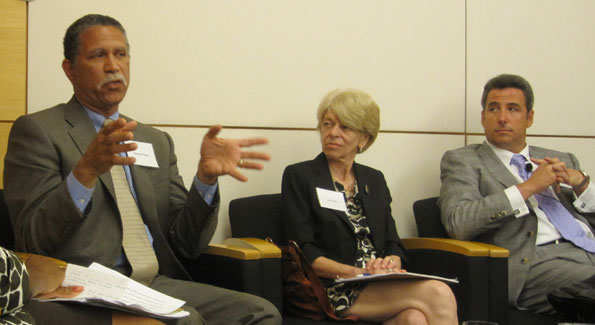The Community Foundation’s philanthropic guest speakers advocate change, not charity.
By Jane Hess Collins

Sam Parker discusses the Prince Georges County community initiatives while Jane Lang and Devin Schain listen. Photo by Jane Hess Collins.
Mark R. Kramer’s “Catalytic Philanthropy,” which first appeared in the Stanford Social Innovation Review in the fall of 2009, argued for cross-sector collaboration among philanthropists, businesses, nonprofits and the public sector to create lasting, high-impact change. The Community Foundation for the National Capital Region (CFNCR) chose catalytic philanthropy as its message during its annual meeting at the Ronald Reagan Building and International Trade Center on June 23.
Terri Lee Freeman, CFNCR president, opened the program by sharing highlights from the first annual report of their Neighbors in Need Fund with board members, donors, and corporate partners. Donors need to see results, said Freeman, as she listed how the Neighbors in Need Fund has helped the district’s underserved since its inception in 2008. With an additional $1 million approved by the CFNCR’s board of trustees and another $300,000 anonymous matching gift, the CFNCR can better invest in quality education and workforce development opportunities. “No one wants to be poor, homeless, underemployed or unable to care for their children,” Freeman declared.
Freeman introduced Aaron Hurst, president and founder of the Taproot Foundation, as the keynote speaker. Early in his professional career, Hurst saw a huge delta between most nonprofits’ vision and capabilities, and spent five years in the for-profit sector to determine why businesses can achieve the scale and success that eludes most nonprofits.
The problem, he concluded, was the lack of a robust infrastructure, since most donors prefer to give toward direct services. Next, Hurst launched the “Reimagining Service” study to determine if volunteer service really made a difference. The study found that the top 11% of nonprofits out-performed the remaining 89% in every measureable category, as long as they used 50 or more volunteers and had an effective volunteer management program
So, yes, service matters as long as it is done on a large scale and managed well.
After Hurst’s remarks, Freeman invited panel members Sam Parker, Jane Lang and Devin Schain to share their passions and what philanthropy meant to them. Each of their stories carried the common themes of building capacity, community, and family influence.
Parker, an urban redevelopment expert and a member of both the Prince Georges County Planning Board and Community Foundation, challenged all county residents to engage and commit to community improvement. The key to creating a movement of public engagement, he said, was to envision the end state, believe in and embody that vision, and embrace it.
Lang, an attorney and arts patron, spearheaded the renovation of Atlas Performing Arts Center in northeast Washington, DC which led to the entire area’s revitalization. Lang credited her family for teaching her the value of commitment to community service and the validation that comes with it. She shared her theatrical debut at age seven, when she produced and starred in a neighborhood Cinderella play. She donated the dollar she raised to the American Cancer Society, and still has the thank-you letter they sent her. Still, Lang cited her most important philanthropic contribution as teaching her children and grandchildren to give.
Schain, president and CEO of Campus Direct, promotes “doing good by doing well” and believes that business and philanthropy are inextricably linked, rather than mutually exclusive. His own employees, he said, are motivated to work hard because they know that more profit for Campus Direct means more scholarship money they can donate to high school students. Influenced by his mother, a breast cancer survivor at age 27 who became an international expert in the psychological aspects of the disease, Schain saw how his mother helped and influence thousands of families.
So what advice did the experts have for anyone undertaking a BHAG (that’s Big Hairy Audacious Goal)? Recruit good people, take one step at a time and never underestimate the power of your passion.
And for the final bit of advice, Schain asked Hurst to get out of his chair and look under the seat. Hurst found a handful of change that Schain had placed there before the meeting.
The moral?
If you want to make change, you need to get off of your behind.
Good lesson for all of us.
Jane Hess Collins is a retired Air Force colonel who inspires people to contribute through writing, speaking and (hopefully) example. She also writes the “Get Out and Give Back” newspaper column, conducts workshops for clients to discover their most intrinsic way to serve, and has established game nights for at-risk families throughout the country. You can contact her here.
